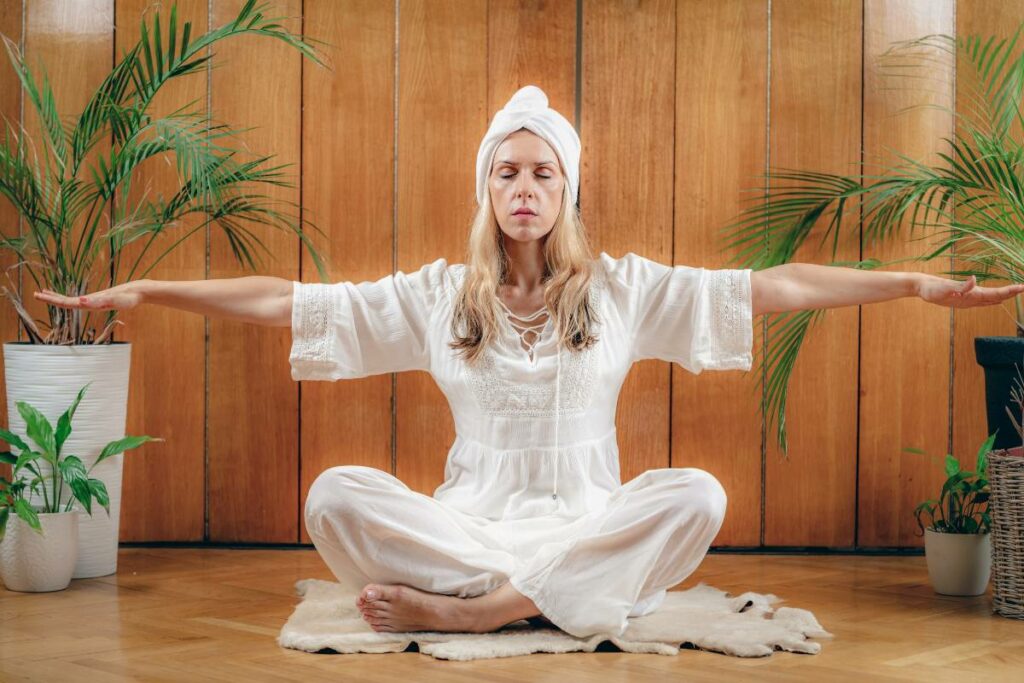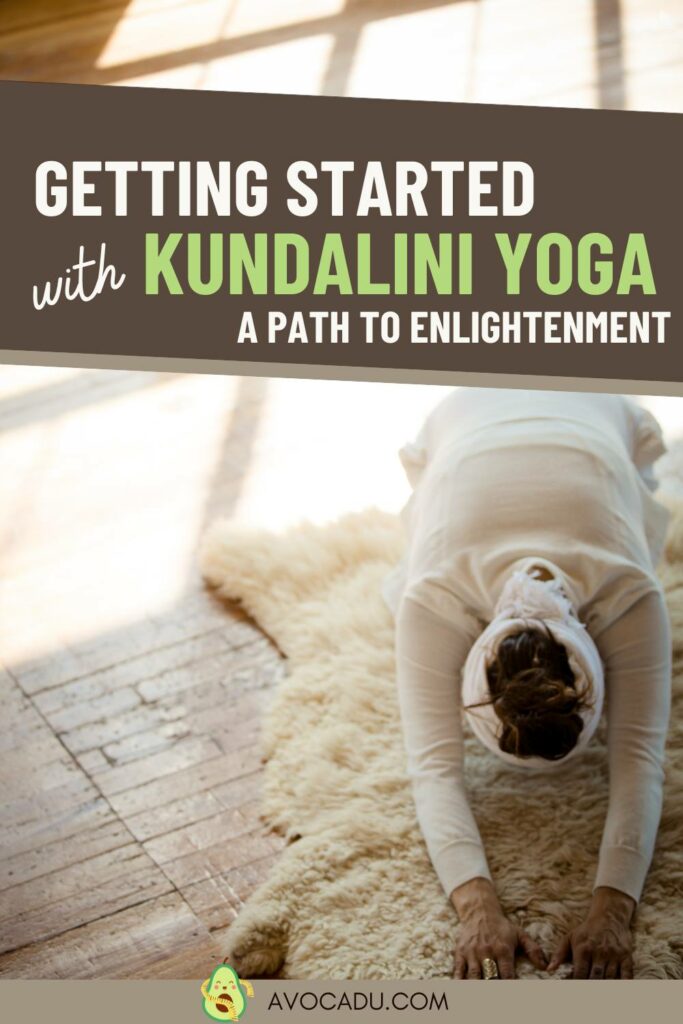Kundalini Yoga: Unleashing Your Inner Energy
Kundalini Yoga, often referred to as the yoga of awareness, occupies a unique place in the vast landscape of yoga practices.
Distinguished by its comprehensive approach to personal development, Kundalini Yoga goes beyond the physical dimension to include mental, emotional, and spiritual growth.
At its core, this practice blends physical postures (asanas), specific breathing techniques (pranayama), and the chanting of mantras to create a holistic exercise that aims not only to strengthen the body but also to clear the mind and awaken the spirit.
Related Article: Exploring Different Styles of Yoga: Which One Suits You Best?

The term ‘Kundalini’ refers to a latent energy believed to lie coiled at the base of the spine like a serpent.
According to yogic tradition, awakening this energy and guiding it through the body’s seven main chakras (energy centers) is key to achieving a heightened state of consciousness and enlightenment.
This process is thought to unleash potential, bring about profound transformations, and connect practitioners to their deepest inner selves.
Unlike other forms of yoga that may emphasize physical prowess or flexibility, Kundalini Yoga places a strong focus on internal experiences.
It is designed to stimulate the flow of Kundalini energy, facilitating a journey of self-discovery and spiritual awakening.
Through its distinctive combination of techniques, Kundalini Yoga seeks to purify the body, calm the mind, and elevate the spirit, offering a path to harmony, balance, and insight.
This dynamic form of yoga is accessible to individuals at all levels of fitness and experience, inviting everyone to explore their inner landscapes and unlock the boundless energy within.
Whether you’re drawn to Kundalini Yoga for its physical benefits, its mental clarity, or its spiritual depth, this practice offers a rich and transformative experience that can enrich your life in unexpected ways.
This post may contain affiliate links, which helps keep this content free. Please read our disclosure for more info.
Understanding Kundalini Yoga

Kundalini energy, as envisioned in yogic philosophy, is a potent and dormant force situated at the base of the spine. This energy is often depicted as a coiled serpent lying in wait, symbolizing untapped potential and spiritual power.
The primary objective of Kundalini Yoga is not just to awaken this slumbering energy but to masterfully facilitate its ascent through the body’s seven main chakras or energy centers, which are positioned along the spine up to the crown of the head.
This journey of the Kundalini energy is believed to unlock each chakra, leading to a harmonious balance of the physical, emotional, and spiritual aspects of our being, and ultimately culminating in enlightenment or a profound awakening to one’s true self.
The process of awakening the Kundalini is delicate and requires guidance and patience. It involves a series of carefully designed exercises and techniques that prepare the body and mind for the energy’s ascent.
These practices include but are not limited to, specific postures (asanas), controlled breathing (pranayama), chanting of mantras, and meditation. Together, they generate heat and energy within the body, helping to dissolve any blockages that may impede the flow of Kundalini.
Each chakra, from the root to the crown, represents different aspects of our existence, from basic survival instincts and creativity to love, communication, and spiritual connection.
As Kundalini energy rises, it is believed to activate and balance these centers, enhancing the practitioner’s physical health, emotional stability, and mental clarity.
This activation is often accompanied by profound spiritual insights, heightened awareness, and a deep sense of interconnectedness with all living things.
Understanding the depth and power of Kundalini Yoga requires an appreciation of its goals beyond physical health. While the benefits can include improved flexibility, stronger muscles, and better stress management, the true essence of Kundalini Yoga lies in its ability to transform and elevate.
Practitioners often describe experiences of bliss, deep peace, and an overwhelming sense of unity with the universe during and after their practice.
However, because of its powerful nature, Kundalini Yoga should be approached with respect and ideally under the guidance of an experienced teacher.
This ensures that practitioners are properly supported as they embark on this transformative journey, allowing them to safely experience the profound changes that Kundalini awakening can bring about.
Key Components of Kundalini Yoga

Kundalini Yoga is distinguished by its structured approach, utilizing a series of specialized techniques to awaken and elevate the Kundalini energy.
These techniques are designed not just for physical or mental well-being but for the profound spiritual growth of practitioners. Here’s a closer look at the core components:
Kriyas
At the heart of Kundalini Yoga are the Kriyas, which are meticulously designed sequences combining postures (asanas), breathwork (pranayama), and meditation.
Each Kriya is crafted with a specific goal in mind, whether it’s to boost the immune system, enhance digestive health, increase spinal flexibility, or promote emotional balance. These sequences facilitate the release of physical blockages and the purification of the mind, setting the stage for the Kundalini energy to rise.
Practicing Kriyas can lead to profound changes in one’s physical health, energy levels, and mental clarity.
Mantras and Meditation
Sound and vibration play pivotal roles in Kundalini Yoga through the chanting of mantras. These sacred sounds, often in Gurmukhi or Sanskrit, are designed to alter consciousness and foster a deep meditative state.
By repeating mantras, practitioners can concentrate their minds, reduce stress, and connect to their inner silence. Meditation, both silent and with mantras, is used to cultivate awareness, control the mind, and prepare the practitioner for deeper spiritual experiences.
Together, mantras and meditation are powerful tools for enhancing mental clarity and emotional stability.
Breath of Fire

This rapid, rhythmic breathing technique is a hallmark of Kundalini Yoga, known for its energizing and cleansing effects. Unlike regular breathing patterns, the Breath of Fire focuses on equal, quick exhalations and inhalations through the nose, engaging the diaphragm and abdominal muscles.
This practice is beneficial for increasing oxygen delivery to the brain and body, stimulating the nervous system, and improving concentration and vitality.
Regular practice of the Breath of Fire can also aid in detoxifying the lungs, expanding lung capacity, and enhancing the efficiency of the body’s energy use.
Each of these components plays a crucial role in the practice of Kundalini Yoga, contributing to its effectiveness as a comprehensive system for personal transformation.
Through the diligent practice of Kriyas, engagement with mantras and meditation, and the energizing Breath of Fire, practitioners can experience significant advancements in their physical, mental, and spiritual journeys.
Kundalini Yoga offers a path to holistic health, profound inner peace, and spiritual awakening, making it a deeply rewarding practice for those who commit to its disciplines.
Getting Started with Kundalini Yoga

Embarking on the Kundalini Yoga journey is an exciting step towards personal development and spiritual awakening. Here’s how to begin:
Finding a Class
Kundalini Yoga has gained popularity globally, making it easier to find classes that suit your needs. Local yoga studios often offer Kundalini Yoga sessions, catering to various experience levels from beginner to advanced.
Additionally, the digital age brings the convenience of online classes, providing access to top-notch Kundalini instructors from around the world. Websites and apps dedicated to yoga are good places to start looking for these resources.
When selecting a class or teacher, consider the instructor’s experience, especially in teaching Kundalini Yoga, to ensure a safe and authentic practice.
For home practice, check out Kundalini Yoga with Yogigems on YouTube!
Here’s a short 15-Minute Morning Set to get you started.
What to Expect in Your First Class
Kundalini Yoga is unique, blending intense physical exercises with deep spiritual practices. Your first class might feel different from any other yoga or fitness class you’ve attended. It will likely include a mix of dynamic postures, repetitive movements, breathing exercises, chanting mantras, and periods of meditation.
These elements work together to stimulate and move energy through the body. It’s common to experience a wide range of emotions and physical sensations during a class, from exhilaration and joy to deep introspection.
Embrace these experiences with an open mind and heart, as they are part of the transformative process of Kundalini Yoga.
Essential Gear and Preparation

The physical requirements for starting Kundalini Yoga are minimal. A yoga mat is essential for comfort and stability during postures and movements. Wear loose, comfortable clothing that doesn’t restrict your movements, allowing you to breathe deeply and freely.
It’s also advisable to have a blanket or shawl handy for the relaxation and meditation parts of the class, as your body temperature may drop.
Preparing mentally and physically for Kundalini Yoga involves coming to class with an open mind, ready to explore the depths of your being. Hydration is important, so drink plenty of water before and after the session.
Eating a light meal a couple of hours before class can help ensure you have enough energy for the practice without feeling uncomfortable.
Engaging with the Kundalini Community
Many find the journey into Kundalini Yoga to be deeply personal and transformative. Engaging with the Kundalini Yoga community, either locally or online, can provide support, deepen your understanding, and enrich your practice.
Workshops, festivals, and group meditations offer opportunities to connect with others on similar paths and share experiences.
The Benefits of Regular Practice
Kundalini Yoga is more than just a physical workout; it’s a holistic practice that nurtures the body, mind, and spirit. Regular engagement with Kundalini Yoga can lead to profound changes in your overall well-being.
Physical Health
- Increased Energy: Kundalini Yoga’s unique blend of movements, breath work, and meditation stimulates the body’s energy systems, leading to a noticeable boost in vitality.
- Improved Flexibility: Although not as focused on physical postures as some other forms of yoga, Kundalini Yoga includes asanas that enhance flexibility and mobility.
- Stronger Immune System: The practice is known to enhance the body’s defense mechanisms, reducing susceptibility to illnesses.
- Detoxification: Through its dynamic exercises and breathing techniques, Kundalini Yoga promotes the elimination of toxins, supporting better organ function and overall health.
- Balanced Hormones: Certain kriyas and meditations are specifically designed to balance the endocrine system, which can improve mood, sleep, and overall hormonal balance.
Mental and Emotional Wellness
- Stress and Anxiety Reduction: The meditative aspects of Kundalini Yoga, along with its focused breathing exercises, are highly effective in lowering stress levels and alleviating anxiety.
- Emotional Healing: By encouraging self-awareness and the expression of pent-up emotions, Kundalini Yoga can facilitate deep emotional release and healing.
- Enhanced Mental Clarity and Peace: Regular practice helps clear the mind of clutter and confusion, leading to greater mental clarity, focus, and inner peace.
- Resilience: Kundalini Yoga strengthens the nervous system, making practitioners more resilient to the pressures and stresses of daily life.
Spiritual Growth
- Deeper Spiritual Connection: Kundalini Yoga is often described as a journey of self-discovery, leading practitioners to a deeper understanding of their true self and their place in the universe.
- Sense of Unity: Many practitioners report experiencing a profound sense of oneness with the world around them, fostering a feeling of interconnectedness and compassion.
- Awakening of Inner Potential: The practice aims to awaken the dormant Kundalini energy, which is believed to hold the key to unlocking one’s full spiritual and creative potential.
- Heightened Intuition: As individuals become more attuned to their inner selves, they often notice an increase in intuitive abilities, guiding them in their personal and professional lives.
A Guide to Your Kundalini Yoga Session

Every Kundalini Yoga session is an opportunity to connect with your inner self and harness your spiritual energy. Here’s how to navigate through a session:
Preparing Your Space and Yourself
- Create a Serene Environment: Choose a quiet, clean area where you can practice undisturbed. You may want to enhance the space with elements like candles or incense to help focus and relax your mind.
- Set an Intention: Before beginning, reflect on what you wish to achieve in this session. It could be anything from seeking inner peace, clarity on a matter, or simply enhancing your well-being.
Opening the Session
- Tune In: Start by chanting the Adi Mantra, “Ong Namo Guru Dev Namo,” three times. This helps you tune into the divine wisdom within and sets a sacred tone for your practice.
Main Practice
- Engage in a Kriya: Select a kriya that aligns with your intention. This series of exercises, including postures, breath work, and mantras, is designed to work towards a specific outcome. Follow each step with attention and care, maintaining awareness of your body’s responses.
- Breathing Techniques: Pay special attention to the breathing instructions within the kriya. Techniques like the Breath of Fire not only energize and cleanse but also prepare your mind for meditation.
- Mantra Chanting and Meditation: After the physical exercises, transition to mantra chanting and meditation. These are critical for calming the mind and deepening your spiritual connection. The vibrations from the mantras aid in focusing your thoughts and elevating your consciousness.
Closing the Session
- Relaxation: Conclude the active part of your session with a relaxation period in Corpse Pose (Savasana). This allows your body and mind to assimilate the energies activated during the practice.
- Closing Chant: Gently come back to a seated position and end your session with a closing chant or song, such as the “Long Time Sun” song. This sends off your practice on a note of gratitude and blessing.
Reflection and Regular Practice
- Reflect on Your Experience: Take a few moments post-session to reflect on how you feel, noting any changes in your physical, emotional, or spiritual state.
- Consistency is Key: To fully experience the benefits of Kundalini Yoga, regular practice is important. Aim for a routine that fits your schedule and lifestyle, allowing your practice to grow and evolve.
Guidance from Experienced Teachers
- Seek Knowledge and Support: Whenever possible, practice under the guidance of experienced Kundalini Yoga teachers. They can offer personalized advice, adjust your techniques, and support your spiritual journey.
Are You Ready to Transform with Kundalini Yoga?

Kundalini Yoga presents an unparalleled approach to personal growth, inviting you into a practice that’s both ancient and deeply relevant. It’s more than just a series of exercises; it’s a pathway to unlocking your full potential, harnessing your internal energy, and achieving a state of holistic well-being.
This practice calls for an open heart and mind, urging you to explore the depths of your being and the breadth of your capabilities. Whether you’re seeking physical improvement, mental clarity, emotional stability, or spiritual enlightenment, Kundalini Yoga offers the tools and teachings to guide your journey.
The growth of Kundalini Yoga’s popularity reflects a collective desire for meaningful, profound change. By embracing this practice, you join a movement towards greater awareness, harmony, and fulfillment. Share your journey, learn from others, and contribute to the collective wisdom that makes Kundalini Yoga so special.
Let’s ask again: Are you ready to transform with Kundalini Yoga?

